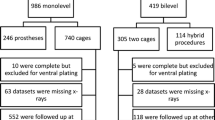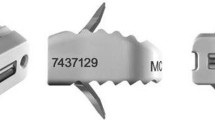Abstract
Anterior cervical decompression and fusion with anterior plating of the cervical spine is a well-accepted treatment for cervical radiculopathy. Recently, to minimise the extent of surgery, anterior interbody fusion with cages has become more common. While there are numerous reports on the primary stabilising effects of the different cervical cages, little is known about the subsidence behaviour of such cages in vivo. We retrospectively reviewed eight patients with cervical radiculopathy operated upon with anterior discectomy and fusion with a stand-alone titanium cervical cage. During surgery, only the cartilage portion of the end plate was removed and the cages were filled with autologous cancellous bone graft from the iliac crest. To assess possible subsidence or migration, three different radiographic measurements in the sagittal plane were taken for each case, postoperatively and at the latest follow-up. Subsidence was defined as any change in at least one of our parameters of at least 3 mm. Follow-up time was 12–18 months (average 15 months). Five of the nine fused levels had radiological signs of cage subsidence. No posterior or anterior migration was observed. However, subsidence did not correlate with clinical symptoms in four of the five patients. The remaining patient with signs of subsidence, whose neck pain and neurologic symptoms had regressed in the early postoperative course, suffered recurrence of radiculopathy 6 months after the surgery. Her symptoms were explained by the subsidence of the cage and the subsequent foraminal stenosis observed on the magnetic resonance imaging (MRI) scan. At 15 months' follow-up, her cage was broken. Our preliminary results, so far limited in number, represent a serious warning to the proponents of stand-alone cervical cages





Similar content being viewed by others
References
Cahil CW, Sonstein WS (1999) Anterior cervical instrumentation. Tech Neurosurg 5:133–145
Curylo LJ, Lindsey RW, Doherty BJ, LeBlanc A (1996) Segmental variations of bone mineral density in the cervical spine. Spine 21:319–322
Floyd T, Ohnmeiss D (2000) A meta-analysis of autograft versus allograft in anterior cervical fusion. Eur Spine J 9:398–403
Hacker RJ (2000) A randomized prospective study of an anterior cervical interbody fusion device with a minimum of 2 years of follow-up results. J Neurosurg 93 [2 Suppl]:222–226
Hollowell JP, Vollmer DG, Wilson CR, Pintar FA, Yoganandan N (1996) Biomechanical analysis of thoracolumbar interbody constructs: how important is the endplate? Spine 21:1032–1036
Kettler A, Wilke HJ, Claes L (2001) Effects of neck movements on stability and subsidence in cervical interbody fusion: an in vitro study. J Neurosurg 94 [1 Suppl]:97–107
Matge G, Leclercq TA (2000) Rationale for interbody fusion with threaded titanium cages at cervical and lumbar levels. Results on 357 cases. Acta Neurochir 142:425–433
Oxland TR, Lund T (2000) Biomechanics of stand-alone cages and cages in combination with posterior fixation: a literature review. Eur Spine J 9 [Suppl 1]:95–101
Panjabi MM, White AA, Johnson RM (1975) Cervical spine mechanics as a function of transection of components. J Biomech 8:327–336
Profeta G, de Falco R, Ianniciello G, Profeta L, Cigliano A, Raja AI (2000) Preliminary experience with anterior cervical microdiscectomy and interbody titanium cage fusion (Novus CT-Ti) in patients with cervical disc disease. Surg Neurol 53:417–426
Shimamoto N, Cunningham BW, Dmitriev AE, Minami A, McAfee PC (2001) Biomechanical evaluation of stand-alone interbody fusion cages in the cervical spine. Spine 26:E432–436
Shono Y, McAfee PC, Cunningham BW, Brantigan JW (1993) A biomechanical analysis of decompression and reconstruction methods in the cervical spine. Emphasis on a carbon-fiber-composite cage. J Bone Joint Surg Am 75:1674–1684
van Limbeek J, Jacobs WC, Anderson PG, Pavlov PW (2000) A systematic literature review to identify the best method for a single level anterior cervical interbody fusion. Eur Spine J 9:129–136
Vavruch L, Hedlung R, Javid D, Leszniewski W, Shalabi A (2002) A prospective randomized comparison between the Cloward procedure and a carbon fiber cage in the cervical spine: a clinical and radiologic study. Spine 27:1694–1701
Wigfield CC, Nelson RJ (2001) Non autologous interbody fusion materials in cervical spine surgery: how strong is the evidence to justify their use? Spine 26:687–694
Wilke HJ, Kettler A, Goetz C, Claes L (2000) Subsidence resulting from simulated postoperative neck movements: an in vitro investigation with a new cervical fusion cage. Spine 25:2762–2770
Author information
Authors and Affiliations
Corresponding author
Rights and permissions
About this article
Cite this article
Gercek, E., Arlet, V., Delisle, J. et al. Subsidence of stand-alone cervical cages in anterior interbody fusion: warning. Eur Spine J 12, 513–516 (2003). https://doi.org/10.1007/s00586-003-0539-6
Received:
Revised:
Accepted:
Published:
Issue Date:
DOI: https://doi.org/10.1007/s00586-003-0539-6




